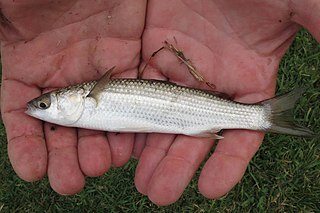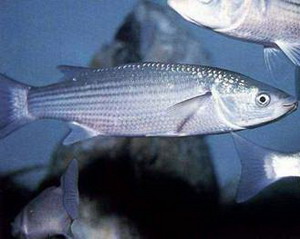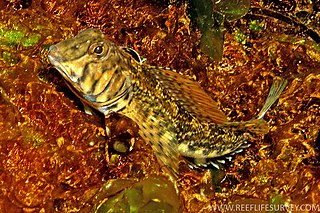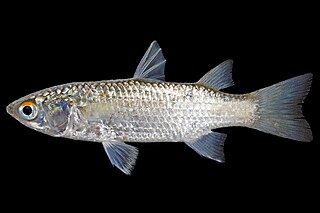
The mullets or grey mullets are a family (Mugilidae) of ray-finned fish found worldwide in coastal temperate and tropical waters, and some species in fresh water. Mullets have served as an important source of food in Mediterranean Europe since Roman times. The family includes about 78 species in 20 genera.
Chelon is a genus of mullets found in coastal marine waters, estuaries and rivers in the Atlantic Ocean and Arabian Sea.

The sand grey mullet is a species of mullet found in coastal marine waters of Australia.

The freshwater mullet is a species of fish in the family Mugilidae. It is endemic to South Africa.
Cepola pauciradiata, the Guinean bandfish, is a species of marine ray-finned fish belonging to the family Cepolidae, the bandfishes.. It is found on the Atlantic coast of Africa.

Chelidonichthys, the smallscaled gurnards, is a genus of marine ray-finned fishes belonging to the family Triglidae, the gurnards and sea robins. These gurnards are found in the Eastern Atlantic, Indian and Western Pacific Oceans.

The piper gurnard, also known as the piper or the lyre gurnard, is a species of marine, demersal ray-finned fish from the family Triglidae, the gurnards and sea robins. It is found in the eastern Atlantic Ocean and the Mediterranean Sea. It is the only species in the monotypic genus Trigla.

The thinlip mullet is a species of fish in the family Mugilidae. It is found in shallow European waters and is a migratory species.

Lepidoblennius marmoratus, known commonly as the western jumping blenny, is a species of triplefin blenny in the genus Lepidoblennius. It was first described by William John Macleay in 1878.

Chaetodon hoefleri, the four-banded butterflyfish, is a species of marine ray-finned fish, a butterflyfish from the family Chaetodontidae. It is native to the tropical eastern Atlantic and has been recorded in the Mediterranean.

Mugil thoburni, Thoburn's mullet, is a species of grey mullet, from the family Mugilidae, found in the eastern Pacific Ocean. It is most common around the Galapagos Islands but does occur on the coasts of Central America and South America as well. This species grows to a length of 29.5 centimetres (11.6 in) TL. It was formerly regarded as the only known member of the genus Xenomugil.

Chaetodipterus is a genus of marine ray-finned fishes belonging to the family Ephippidae, the spadefishes. These fishes are found in the Atlantic and eastern Pacific Oceans.

Apsilus is a small genus of marine ray-finned fish, snappers belonging to the family Lutjanidae. The two species within the genus are native to the Atlantic Ocean,

Planiliza is a genus of mullets found in coastal marine waters, estuaries and rivers in the Indo-Pacific.

Planiliza carinata, the keeled mullet, is a species of grey mullet from the family Mugilidae which is found in the western Indian Ocean and eastern Mediterranean Sea. It colonised the Mediterranean by Lessepsian migration from the Red Sea through the Suez Canal. The keeled mullet is a species of minor importance in commercial fisheries.
The Diassanga mullet is a species of ray-finned fish, grey mullet from the family Mugilidae. It is found in the eastern Atlantic around the coasts of West Africa.
Chelon tricuspidens, the striped mullet, is a species of ray-finned fish from the family Mugilidae. It is found in southern Africa where its known range comprises Mossel Bay and the Kosi Estuary in South Africa. Its habitatis muddy areas in estuaries. This species and the Diassanga mullet are closely related and these two taxa seem to have separated when the Benguela Current, as it exists today, was formed about 3-12 million years ago.

The Burmese mullet is a species of freshwater ray-finned fish, a mullet belonging to the family Mugilidae. It is the only species in the genus Sicamugil. It is found in the drainage systems of the Sittang and Irrawaddy rivers in Myanmar.
Crenimugil buchanani, the bluetail mullet, is a member of the ray-finned fish family Mugilidae widely found throughout the Indo-Pacific. This species can reach a length of 100.0 centimetres (39.4 in) SL.

Lepidotrigla spiloptera, the spotwing gurnard, spotfin gurnard or red-fringed gurnard, is a species of marine, demersal ray-finned fish from the family Triglidae, the gurnards and sea robins. It has a wide Indo-Pacific distribution.
















